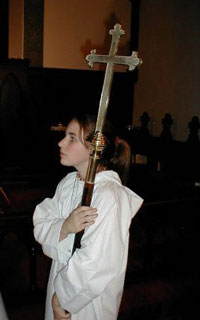 THE CROSS is usually a principal sign associated with a church building. But do we devalue it by overuse? I see crosses put on the wine and water cruets. I see them on stoles. I see them put on chairs – so that we are sitting on or leaning against, hiding… It is as if a symbol is not trusted to convey meaning unless we put another sign or symbol on top of it – and this second one is most regularly a cross…
THE CROSS is usually a principal sign associated with a church building. But do we devalue it by overuse? I see crosses put on the wine and water cruets. I see them on stoles. I see them put on chairs – so that we are sitting on or leaning against, hiding… It is as if a symbol is not trusted to convey meaning unless we put another sign or symbol on top of it – and this second one is most regularly a cross…
A spire is often built to lift a cross to be the highest feature. What is a spire without a cross…
In an entrance procession we bring in the cross as one of the signs around which the community is gathering for worship. This cross can be placed in a central place in our worship space. Not leaning against a wall! Not brought in – and then hidden off to the side where most cannot see it. What does it mean if we already have a community cross visible in place – why are we bringing in this second(ary) cross as we start worship together?
When we are not gathered for the community’s worship, this community cross can still be placed in the central point of our worship space so that those who come in during the week for a time of prayer have the community’s cross as one of the foci for devotion. There will need to be a stand for the cross, or a hole in the floor in which the cross is inserted. Does the community want it always in the same place, or movable?
This post is, hopefully, useful for a number of contexts. It is particularly offered as one in a series for reflection as we begin planning the building of a number of church buildings after the closing of dozens of church buildings because of the Canterbury earthquakes.
Can you add some ideas, responses, even further questions to help people’s reflections…




A spire without a cross = Mormon.
In the American experience, it seems that, 1) Bigger is better, and 2) More is better. Unfortunately the Church has too often bought in to this flawed ideal.
I’m with Rev. Sam. That’s the way it is here…mostly. But for me I still se my beloved Father Timberlake sitting us all down at 8 and letting us feel the cross that is walked forward every Sunday with such passion and joy while reminding us why it is beautiful, and terrible too.
For Toni (above): I’d like to point out that most spires without crosses are actually not (necessarily) Mormon – they could be minarets or Hindu or Buddhist or Shinto – and others too numerous to name. It seems that spires of some type or another are a common architectural element across cultures. Even a totem pole functions like a spire – and has a spiritual connotation.
As for crosses, I agree with Bosco that cruets, candles, etc. contain elements that have their own meaning. (not every Icon has a cross in it, for example) And I too find it distracting when too many “symbols” or “signs” multiply in a liturgical setting. Simplicity is best it seems to me. Benedictine simplicity comes to mind.
Another couple thoughts which do not relate to church architecture. Many years ago I spent a summer in Bavaria – studying German. I did a lot of short trips in the surrounding countryside and I found it very moving that every single hill (really they were worn down mountains of course) had a cross at the very top. This was a touching sight for some reason, maybe a reminder that though I was in a foreign land, people had climbed every single hill – at some point carrying a cross to plant atop it. Each hill’s message was written in that cross – a sign that someone had placed it there – for all to see from afar or find after a long climb. (I don’t recall such crosses on hills in France, for example.)
Then I had the thought of cemeteries. Military cemeteries in particular have row upon row (marching up and down hills at times) of identical, simple crosses. I think most of us find such sights moving as well.
So sometimes a simple cross (or rows of them) in a landscape can say so much. But other times – as you mention, Bosco – putting crosses on every solitary utensil in a church, which is already a sacred space, seems superfluous.
It’s a very interesting question you’ve posed here. Especially as most churches already incorporate the cross into the very floor-plan so that one stands or sits “wihin” the cross.
Thanks for those points, TheraP. Your point about hills reminds me of the centuries-old practice of crosses placed at intersections of roads or walking tracks. Your reminder about the ancient tradition of our being inside the cross in most church buildings is also very important. Blessings.